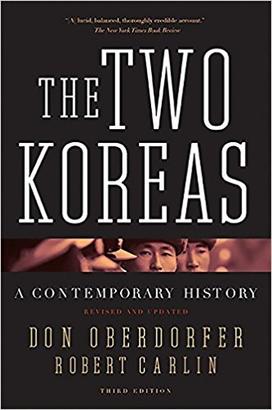With North Korea’s weapons program making headlines, one might easily forget how far-fetched the nation’s nuclear ambitions may have seemed 20 years ago. PAW printed an article responding to that attitude in May 1998. The review of The Two Koreas: A Contemporary History highlighted the book’s claim that a “political crisis over the North Korean nuclear weapons program” brought America close to war in 1994. The piece characterized this information as “something of a bombshell.”

The Two Koreas did not wipe away the aura of mystery in the North. In fact, Oberdorfer “leaves us with a warning. Hold onto your hats, he writes. Korea is always full of surprises.” That prescient recognition gives The Two Koreas continued relevance. It remains in print, and Oberdorfer co-authored a revised edition — his final published work — in 2013. He died in 2015.
Below, read Williamson’s full review of The Two Koreas.
Korea: A Dimly Understood Country
A national story worthy of Hollywood
By David Williamson ’84
(From the May 20, 1998, issue of PAW)
About two-thirds of the way through The Two Koreas, Don Oberdorfer ’52’s fine general-interest history of post-war Korea, the veteran Washington Post foreign correspondent drops something of a bombshell. In the spring and summer of 1994, he matter-of-factly asserts, the political crisis over the North Korean nuclear weapons program brought America closer to the brink of war than at any time since the Persian Gulf conflict.
How close? “It is instructive,” writes Oberdorfer, “that those in the U.S. and [South Korean] governments who were closest to the decisions are among those, who in retrospect, rate the chances for hostilities to have been the highest.: Or in the words of an Air Force lieutenant general, “Inside we all thought we were going to war.”
If you happened to miss this geopolitical crisis, don’t feel bad — so did everyone else. That is the way it is for most Americans with most things Korean. Indeed, to the Western audience, Korea remains something of a mystery, a dimly understood land seen primarily through the distorting prism of old reruns of M*A*S*H.
Fiercely patriotic, Koreans are annoyed at how little Americans (and virtually everyone else, for that matter) know about Korea or seem to care. And the Koreans have a point. By any measure, the recent history of Korea, both North and South, makes for one hell of a story, with a plot line worthy of a Hollywood epic. Cold War tension, spies and spectacular assassinations, corruption on a colossal scale, political unrest, and heroic prodemocracy demonstrators, military dictators, and Stalinist relics — Korea has seen them all over the past 45 years. It makes for remarkable reading, and Oberdorfer delivers handsomely.
His work on the political evolution of South Korea is particularly meaty. While giving due attention to the Korean “economic miracle,” the export-led strategy that transformed the South Korean economy from postwar ruins to its current prominence as a top-10 economic power, Oberdorfer does not spend too much time retreading this ground, already the domain of development economists. Instead, he focuses on the tumultuous political intrigue that marked Korea's run of military-dominated governments, starting in the early 1960s with the accession of Park Chung Hee to power.
And intrigue there was in spades. Park, who was later murdered by his own intelligence chief, ruthlessly crushed any opposition to his rule, imprisoning thousands of dissidents and even approving the kidnapping and execution of his main rival, Kim Dae Jung. (In a wonderful historical twist, this is the same Kim Dae Jung who was installed earlier this year as the first Korean president from an opposition party. Quick footwork by the U.S. government prevented his captors from tossing him into the Sea of Japan.)
In addition to his strong-arm tactics, Park was also known for his lucrative dealings with the chaebol, the handful of conglomerates that controlled nearly every aspect of Korean economic life. But it was Park’s successor, a general named Chun Doo Hwan, who really pushed corruption to new heights. Oberdorfer is at his best in describing how Chun and his successor, Roh Tae Woo, extorted hundreds of millions of dollars from Korean businesses. Noncompliance with their demands came at a steep price: when one prominent conglomerate called the Kukje Group resisted these payoffs, Chun wasted no time orchestrating its immediate collapse.
In contrast to his deft handling of South Korean politics, however, Oberdorfer falls short in his treatment of the North. In part, this is not his fault; reliable information on North Korea is scant at best, and accurate political intelligence the most scarce of all.
Even so, Oberdorfer could have enlivened The Two Koreas with a richer analysis of the Pyongyong regime and the “Great Leader,” Kim Il Sung, the charismatic founder of the North Korean state. Indeed, the surrealistic world of North Korea — its highly regimented society, the cult worship of Kim Il Sung, the formidable state propaganda machine, and the mismanaged economy — if anything makes for a better story than the corruption-ridden South. And there are also the unanswered questions about North Korea as a rogue state: why, for instance, the unending campaign to dig tunnels under the Demilitarized Zone (one was big enough to drive trucks through), or the various assassination schemes and terrorist acts?
But this is a small quibble, and given the notoriously unpredictable leadership in the North, Oberdorfer is doubtless wise to curb any temptation to speculate about the causes and motivations of the North Korean leadership. Similarly, he makes no predictions for the future. Instead, with famine rampant throughout the North and economic austerity setting in the South, Oberdorfer leaves us with a warning. Hold onto your hats, he writes. Korea is always full of surprises.
David Williamson, a former PAW staff writer, worked as an editor at the Korea Development Institute in Seoul in 1984-85 as a Princeton-in-Asia fellow.











No responses yet